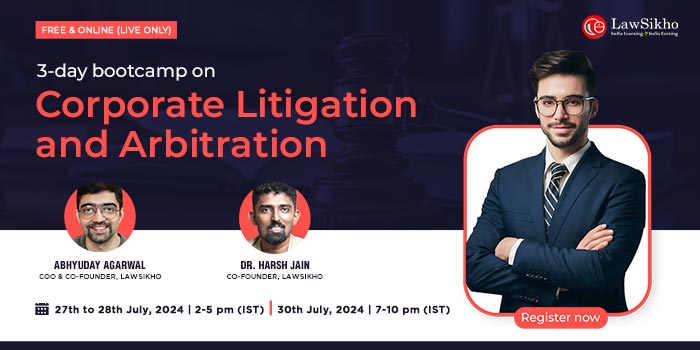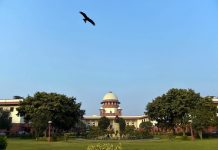This article was written by Oishika Banerji and has been further updated by Shefali Chitkara. This article provides a legal analysis of the landmark case of A.R. Antulay v. R.S. Nayak & Anr (1988). The author aims to give a brief overview of the judgement, facts of the case, important issues raised, contentions made by the parties, and important points that were highlighted by the Court more clearly by referring to various judgements that followed the aforementioned judgement. Further, the author has tried to explore the aftermath and significance of the judgement. The author has also mentioned the legal viewpoints that were considered by the Court while delivering the judgement.
This article has been published by Shashwat Kaushik.
Table of Contents
Introduction
The case of A.R. Antulay v. R.S. Nayak & Anr. (1988) is one of the significant judgments in Indian legal history because it established that corruption cases that are tried by a Special Court cannot be referred to a High Court judge for a hearing. Despite much criticism, the Supreme Court of India was certain that justice had been delivered properly. This subsequently led several legal scholars to assert that the law was being hampered by human foresight.
Mr. Antulay, the appellant in this landmark case, was the then Chief Minister of Maharashtra, who resigned and left office on 20th January 1982, while the respondent, Mr. Nayak, was a political figure with political ties. The lawsuit centres on the appellant’s claim that his fundamental rights had been violated. A seven-judge bench of the Supreme Court had issued a landmark decision, stating that the ruling of the Constitutional bench of the Supreme Court violated Section 7(1) of the Criminal Law (Amendment) Act, 1952, as well as the appealing party’s fundamental rights under Articles 14 and 21 of the Constitution of India. This case is interesting to discuss because the Apex Court has provided a different perspective from which this case can be viewed. The three major legal viewpoints that are to be discussed in this article concerning this landmark case are:
- Constitutional,
- Administrative, and
- Civil law perspective.
This case is significant for the reason that there were serious allegations against the Chief Minister of Maharashtra that made him resign from his position in the year 1982 and this case further delved into the doctrine of separation of powers between the judiciary and the executive branch and established the doctrine of pleasure, which directs the removal of judges.
Case details
Title of the case- A.R. Antulay v. R.S. Nayak & Anr.
Case citation- AIR 1988 SC 1531
Court- Supreme Court of India
Coram of judges- Hon’ble Justice G.L. Oza, Justice Sabyasachi Mukherjee, Justice M.N. Venkatachaliah, Justice Ranganath Misra, Justice S. Natarajan, Justice S. Ranganatham, Justice B.C. Ray (7-judge bench)
Appellant- A.R. Antulay
Respondent- R.S. Nayak
Provisions involved- Articles 13, 14, 21, 32, 134, 136, 139, 141 and 142 of the Indian Constitution; Sections 161, 162, 163, 164 and 165 (now repealed) of the Indian Penal Code, 1860; Sections 374, 406 and 407 of the Criminal Procedure Code, 1973; Sections 6 and 7 of the Criminal Law (Amendment) Act, 1952; and Sections 5 and 6 of Prevention of Corruption Act, 1947 (now as Prevention of Corruption Act, 1988)
Date of decision- April 29, 1988
The case which got overruled- R.S. Nayak v. A.R. Antulay (1984)
Historical background
A resolution was passed by the government of Maharashtra to establish the ‘Indigent Prisoner’s Fund’ for providing legal assistance to indigent prisoners. The fines that were imposed on the convicted persons were used to establish the said fund. This fund was managed by the Chief Minister of Maharashtra, who was the present appellant in this case, namely Mr. A.R. Antulay. In this case, the management of the fund was challenged by one of the members of the legislative assembly, the respondent in the present case, R.S. Nayak. According to him, the management of the said fund was unconstitutional.
Facts of A.R. Antulay vs. R.S. Nayak & Anr. (1988)
The appellant, A.R. Antulay, has been the Chief Minister of the State of Maharashtra since June 1980. In September 1981, one of the members of the legislative assembly went to the Governor of Maharashtra under Section 197 of the CrPC, 1973 and Section 6 of the Prevention of Corruption Act, 1947, to get a sanction to file a case against the appellant. A complaint was also filed with the Additional Metropolitan Magistrate of Bombay under the offences of Sections 161, 165, 384, 420 read with Sections 109 and 120B of the IPC, 1860 and Section 5 of the Prevention of Corruption Act, 1947. The magistrate refused to take any cognizance of these offences, which led to the filing of a revision petition before the Bombay High Court.
A similar complaint was filed by Mr. P.B. Samanth in the form of a writ petition under Article 226 of the Indian Constitution in 1981 against the emergency allotment of concrete in the state to the Indira Gandhi Pratibha Pratishthan Trust. The appellant was made the second respondent in this case. The learned Single Judge of the High Court passed the Nisi rule through a speaking order and made it to return on 23rd November 1981. Nisi rule is a court order that comes into force at a future date unless a cause is shown to the contrary. This order was made absolute in the later hearing. These allegations against the appellant regarding the abuse of power resulted in his resignation from the post of Chief Minister in 1982.
Barrister Abdul Rahman Antulay (hereinafter referred to as “Mr. Antulay” or “appellant”) resigned as Maharashtra’s Chief Minister on January 13, 1982, after the Bombay High Court sentenced him to imprisonment for coercion. The Court found that Antulay had illegally bought Bombay region developers in exchange for more concrete than the quantity distributed by the government to Indira Gandhi Pratibha Pratishthan Trust, which was one of the few trusts he had set up and controlled. The Court eventually released him on bond. However, the Supreme Court later cleared him of the charge.
A complaint was again filed with the Special Judge with few charges, including the claim which was rejected by the Governor. As a response to this, a process was issued to the appellant by the Special Judge, Sh. P.S. Bhutta. The appellant’s concern over jurisdiction was also dismissed by the Special Judge and he determined three Special judges to hear such cases of corruption. Sh. R.B. Sule was appointed as a Special Judge by the state government. The Special Judge discharged the appellant and stated that a member of the Legislative Assembly comes within the definition of ‘Public Servant’ under Section 21 of the Indian Penal Code, 1860 and no valid sanction was obtained for proceeding against him. An appeal was filed against this order under Article 136 of the Constitution of India on 16th February 1984 and the Constitution Bench of the Supreme Court ruled that a member of the legislative assembly is not a public servant under Section 21 of the IPC, 1860, thereby reversing the last order of the Special Judge. Rather than giving back the case to a Special Judge for disposition as required by law, the Hon’ble Supreme Court suo moto removed it from the Special Judge’s Court and transferred it to the Bombay High Court.
Issues raised in A.R. Antulay vs. R.S. Nayak & Anr. (1988)
The following three major issues were raised before the seven-judge bench of the Hon’ble Supreme Court:
- Whether the directions given by the Supreme Court’s Constitutional Bench in February 1984 directing the transfer of the case from the Special Judge to the High Court violate Section 7(1) of the Criminal Law (Amendment) Act, 1952?
- Whether the decision of the Constitutional Bench of the Supreme Court violates Articles 14 and 21 of the Indian Constitution and is inoperative, invalid and illegal?
- Be that as it may, whether the Supreme Court should recall or set aside the decision in present proceedings and whether the same is within the purview of the powers of the Supreme Court or not?
Contentions of the appellant in A.R. Antulay vs. R.S. Nayak & Anr. (1988)
The appellant party had claimed that he was forced to deal with bias without being given an opportunity to present any pleadings or contentions in front of the Court, which he claimed was an infringement of his fundamental right under Article 14 of the Indian Constitution. It was also contended that a litigant’s fundamental right to trial by a Special Judge under Article 21 of the Constitution was violated. The appellant further contended that the fundamental rights of equality and justice, which stipulated that no one should suffer from the brunt of technical faults, were blatantly infringed. The appealing party had also lost a few important rights, namely the ability to appeal to the High Court under Section 9 of the Criminal Law (Amendment) Act and the opportunity to appeal to the Supreme Court under Article 136 of the Constitution.
It was further contended that the principles of the administration of justice, namely, “Actus curiae neminem gravabit” (no one should suffer because of the acts of the Court) and that “the procedural technicalities can not overshadow the substantive justice” were also violated.
This led to the violation of one of the principles of natural justice that encompasses three rights within it:
- No person shall be a judge in his own case. (Nemo judex in causa sua)
- Every person should be given the opportunity to be heard. (Audi Alteram Partem)
- There should always be a reasoned decision.
On the strength of the above mentioned principles, the appellant argued that he was not given an opportunity of being heard which led to the violation of the basic principles of law as well as his fundamental rights.
Contentions of the respondent in A.R. Antulay vs. R.S. Nayak & Anr. (1988)
The respondent argued that the High Court could withdraw the matter from the Special Judge under the Criminal Law Amendment Act by means of Section 407 of the Criminal Procedure Code in appropriate cases.
It was further contended that the contention of the appellant that the transfer was done without giving them an opportunity to present the case is unacceptable. The appellant could have made his allegations through his advocate before the order was made or after the directions were given. Thus, there was no illegality in the order and the appellant did not use the opportunity through his own mistakes.
The issue of whether the superior court had jurisdiction was debated and it was contended that the Court could not be held liable for such allegations unless it had behaved in a Coram non-judice (not before a judge) manner.
Relevant provisions involved
- Articles 13, 14, 21 and 32 of the Indian Constitution, as contended by the appellant, for violating their right to be treated equally in the courts and right of trial under a Special Judge as per Section 7(1) of the Criminal Law (Amendment) Act, 1952.
- Sections 374, 406 and 407 of the Criminal Procedure Code, 1973 which provide for the right to appeal in the Supreme Court to any person convicted on a trial and the power of the Supreme Court and High Court to transfer the cases under certain circumstances. This was also invoked by the appellants as favouring their point of contention.
- Sections 161 and 165 of the Indian Penal Code, 1860 (which have now been repealed) stated that the public servant should not take remuneration from the general public more than what the government provides for and also should not obtain any valuable item without consideration and treated this offence as a cognizable and non-bailable offence.
- Sections 6 and 7 of the Criminal Law (Amendment) Act, 1952, provided the state government with the power to elect as many Special Judges as required under the law.
- Sections 5 and 6 of the Prevention of Corruption Act, 1947 (now Prevention of Corruption Act, 1988) provided for the punishment of criminal misconduct by the public servant while performing his official duty and previous sanction that is necessary to be obtained for the prosecution of any public servant.
Judgment in A.R. Antulay vs. R.S. Nayak & Anr. (1988)
The Supreme Court’s decision, in this case, was given by a 7 judge bench. The judgement was delivered by 4:3 in favour of the appellant. The Bench ruled in 1988 that the ruling of 1984 was unreasonable, unlawful, and unconstitutional under Article 21 of the Indian Constitution because Antulay’s right to use the appeal system was curtailed. The Apex Court stated that Section 406 of the Criminal Procedure Code, 1973 allows for the transfer of criminal cases by the Supreme Court. According to the law, the Court may send a specific case from one high court to the other high court, or from a subordinate criminal court to another criminal court of equivalent or upper-level jurisdiction. Subsequently, Article 407 provides for the power of the High Court to transfer cases. Further, Section 6 of the Criminal Law (Amendment) Act, 1952, gives the state government the power to appoint as many Special Judges as required and Section 7 focuses on the cases that are triable by the Special Judges. On the question of the validity of the transfer made by the Court, it was held that the order of transfer of cases to the High Court was not allowed by law and the Apex Court has no power to advise the High Court to take cases that do not fall under its jurisdiction. The Court also noticed that four valuable rights have been infringed upon by the directions of the Constitutional Bench of the Supreme Court:
- The right of trial before the Special Judge as per the procedure established by law.
- The right of revision before the High Court under Section 9 of the Criminal Law (Amendment) Act, 1952.
- The right to appeal before the High Court.
- The right to file special leave to appeal before the Supreme Court under Article 136 of the Indian Constitution by way of a second appeal.
The Court also noted that the directions were passed without observing the principles of natural justice and therefore reversed the judgement given in R.S. Nayak v. A.R. Antulay (1984). Furthermore, the majority opined that the writ of certiorari cannot be issued by a larger bench to quash the order of another bench of the Supreme Court.
It was also observed that merely because a criminal trial has been pending for long against the Chief Minister, it cannot be grounds for the acquittal of the accused. An accused cannot demand his trial with the co-accused as a right.
The Supreme Court lacks the authority to transfer cases to itself. Only the Parliament, by law, has the authority to create or expand the jurisdiction. The judiciary has not been vested with such power. It was also noted that the appellant had the fundamental right under Article 21 of the Constitution for a Special Judge’s trial under Section 7(1) of the Criminal Law (Amendment) Act, 1952, and the right not to suffer as a result of any judgement rendered by the Court in violation of natural justice.
Legal viewpoints
The Code of Civil Procedure, 1908 and its viewpoint
The case of A.R. Antulay v. R.S. Nayak & Anr (1988) is commonly referred to while studying Section 9 of the Code of Civil Procedure, 1908, which talks about the jurisdiction of the civil courts. The Supreme Court clarified in this case that the subject matter of jurisdiction of a court has obtained a legislative character, which is to say that the judiciary has no role in widening or narrowing its jurisdiction by itself.
The judiciary has the power to only interpret the laws and in doing so, it cannot modify the jurisdiction of a court. In this case, the consent of a court is not relevant, as the judiciary cannot surpass the legislative decision-making. Along with the power to create and increase jurisdiction, the legislature has also been given the power to confer a right of appeal or take away the same from any court. The Parliament alone has the power to do it under law and no court, whether superior or inferior or both combined, can modify the jurisdiction of the court or divest a person of his or her rights to go for revision and appeal.
Constitutional viewpoint
The rule of law is at the core of our democracy, which means we need an independent judiciary and judges who can make decisions regardless of the political winds that are blowing. The other branches of the government, including the executive and legislative branches, must not obstruct the judiciary’s ability to do justice. Judges must be able to carry out their duties without fear of reprisal or favour. The primary aim of judicial independence is for judges to be able to settle a matter before them based on the law without being affected by any other element.
Though there is no clear provision in the Indian Constitution in relation to the separation of powers, the independence of the judiciary and the rule of law are fundamental characteristics of the Constitution that cannot be changed, as the Hon’ble Supreme Court observed in the case of S.P. Gupta v. Union of India (1962).
Article 50 of the Indian Constitution specifically mentions the independence of the judiciary, that is, the separation of the judiciary from the executive organ of the government. Although different compartments function with different roles in the parliamentary form of government, hardly can the executive and the legislature be distinguished from each other. What is interesting to note in this viewpoint, when put on the same plate as the present case, is that the determination of jurisdiction does not come under the ambit of judicial independence.
This is because the independence of the judiciary does not signify taking away the legislative power of law-making; instead, what it does mean is to interpret the laws made by the legislature in such a way so that a common man can understand the meaning of the same. Thus although the judiciary is supposed to be independent of the other two organs of the Indian government, it cannot determine its own jurisdiction.
Administrative perspective
Article 12 of the Indian Constitution defines “State”. It states that the term ‘State’ includes the central and state governments, Parliament and legislatures, and all local or other authorities functioning under India’s government or Indian territory. Whether the judiciary is included in the broad term “State” is a significant question to be addressed in this context. The judiciary’s position under Article 12 is based on judicial and non-judicial decisions, whereby if the judiciary is deciding cases, it cannot be referred to as the State.
However, if it is performing non-judicial functions, it is included in the definition of State, because if the courts are completely exempt from the State, they will have unrestricted power to make laws that violate fundamental rights. This is backed by Article 13, which provides that any law that violates basic rights is unconstitutional, and since courts have the power to establish laws, this suggests that they are performing a State duty. Article 141, on the other hand, states that the Supreme Court’s decision is binding on all courts within India’s territory. As a result, the Supreme Court’s verdicts are unassailable, but the lower court’s decisions can be appealed if they infringe fundamental rights.
The Supreme Court reaffirmed and ruled in Rupa Ashok Hurra v. Ashok Hurra (2002) that no judicial action could be deemed to violate any fundamental right. It was claimed to be an accepted legal position that superior courts of justice do not fall under the ‘State’ or ‘other authorities’ ambit as provided in Article 12. As a result, while courts execute administrative functions, they remain within the scope of the State’s definition and cannot infringe on citizens’ fundamental rights. But they do not fall under the definition of state when they make judicial decisions.
Therefore, it will be ideal to mention that the argument that the judiciary can expand or contract its jurisdiction while executing administrative functions will not hold much ground as the judiciary has not been vested with the law-making power that the legislature has inherited.
Important judgments referred
Gurcharan Das Chadha v. State of Rajasthan (1966)
There was an identical question in this case before the Supreme Court. The state government directed the trial to be done before the Special Judge of Bharatpur. The petitioner moved the Court for transfer to another state. The Court noted that Section 7 of the Act mandated the trial only by the Special Judge, which is an essential condition for trial under Section 6. Therefore, the Court held that it can transfer a case only from one Special Judge to another Special Judge but this position was limited to the power under Section 527 of the previous Code and is not a relevant precedent for the proposition that it cannot transfer to the Court other than a Special Judge Court or the High Court.
Kiran Singh v. Chaman Paswan (1954)
To answer the question regarding the challenge to the directions of the Supreme Court to the larger bench of the Supreme Court, the Court observed the findings of this case, wherein it was held that a decree when passed without jurisdiction is nullity and its validity can be set up at any stage. A defect of jurisdiction strikes at the authority of the Court to pass any order.
Raja Soap Factory v. S.P. Shantharaj (1965)
This case was regarding the jurisdiction of the High Court. It was held that “jurisdiction” means the scope of the power that is given to any court by its Constitution to try any case and it cannot be enlarged or extended because the Judge deemed it to be for an extraordinary situation. Therefore, the Court in the present case noted that the power to transfer any case conferred by Section 406 of the Criminal Procedure Code does not relate to the Special Court. This does not authorise the transfer from the Special Judge to the Supreme Court and then to any of the High Courts.
Ledgard v. Bull (1885)
In this case, the Apex Court held that under Section 25 of the previous Civil Procedure Code, the superior Court was not able to make an order of transfer unless the court from which the transfer had to be made had jurisdiction over it. Similarly, in the instant case, under Section 407 of the present Code, the High Court cannot transfer to itself any proceedings under Sections 6 and 7 of the said Act. The Supreme Court, by transferring the case to itself, had not acquired a larger jurisdiction and the fact that the objections were not made against the directions cannot act as a waiver.
Significance of the judgement in A.R. Antulay vs. R.S. Nayak & Anr. (1988)
- The Supreme Court noted that it has no jurisdiction to suo moto direct transfer any case from the Special Court to the High Court for speedy trial.
- This case has established a significant principle regarding the management of funds by the government, subject to transparency, accountability and other constitutional provisions.
- The Court also focused on the established principles of separation of powers and rule of law under the Constitution of India by noting that the power of management of public funds lies with the legislature and not the executive.
- The judgement has made a significant change in the Indian political system and provided for increased scrutiny of the funds by government officials.
- The judgement has contributed to the growth of constitutional jurisprudence and good governance.
- The Court also established that the “State” as per Article 12 of the Indian Constitution will include courts only when they are performing non-judicial functions and not while they are performing their judicial functions.
Brief on the judgement of R.S. Nayak v. A.R. Antulay (1984)
The judgement in this case was given by a five-judge bench of the Supreme Court- D.A. Desia, R.S. Pathak, O. Chinnappa Reddy, A.P. Sen and V.B. Eradi, JJ. On similar facts as mentioned above, the Supreme Court in this case held that sanction for prosecution of a person who has committed the offence in the capacity of Chief Minister is not required. This is because the cognizance of such an offence was taken after he had ceased to be a Chief Minister, although he is still an MLA. The Court also stated that an MLA does not come under the definition of a public servant and, therefore, set aside the order of the Special Judge. MLA is not receiving his remuneration or salary from the government for performing any public duty. Therefore, he does not fall under the definition of “public servant” in Section 21 of the Indian Penal Code. However, the same was overruled in the case of P.V. Narasimha Rao v. State (CBI) (1998) wherein the Court held that an MLA has to be given the status of a public servant for the purposes of the Act, although there is an absence of authority who can give sanction for their prosecution.
Important judgments which referred to the case of A.R. Antulay v. R.S. Nayak (1988)
There are various judgements that refer to the landmark decision in the case of A.R. Antulay v. R.S. Nayak (1988). A few of the important judgements are:
Asit Kumar Kar v. State of West Bengal & Ors. (2009)
Facts of the case
In this case, the All Bengal Excise Licensees’ Association filed a writ petition in Calcutta High Court challenging the policy of West Bengal of granting additional licences for foreign liquor, however, this was withdrawn. During its pendency, an interim order was passed, which stayed the grant of licences. Further, a contempt petition was filed wherein it was alleged that licences were granted in violation of the stay order but this petition was dismissed. Against this dismissal, a special leave petition was filed and the same was decided by the Court but the directions were given without hearing the persons whose licences were cancelled. A writ petition was filed as per Article 32 of the Constitution of India against the decision.
Issues raised
- Whether the petition filed under Article 32 of the Indian Constitution will be treated as a review petition or a recall petition?
- Does the Supreme Court have the power to recall any matter that was passed without fulfilling the principles of natural justice?
Judgement given
The Supreme Court observed that no adverse order should be given against any party without giving them an opportunity to be heard. The Court noted the observation made in the A.R. Antulay v. R.S. Nayak case, in which it was stated that the violation of the principles of natural justice makes the act null. The Court also held that there is a difference between a petition under Article 32 of the Indian Constitution, a review petition and a recall petition. In a recall petition, the court is not obligated to go into the merits of the case but rather look at the matter that was finalised without allowing an affected party to be heard, and this petition was treated as a recall petition. Thus, the directions were recalled by the Supreme Court in this case.
Khoday Distilleries Ltd. & Anr. v. Registrar General, Supreme Court of India (1995)
Facts of the case
In this case, a writ petition was filed before the Supreme Court as per Article 32 of the Constitution of India after the review petitions were rejected by the Court. The learned counsel for the petitioners submitted that the civil appeals were listed before the Constitution bench for directions and were not heard on merit. It was also stated that the judgement is, therefore, invalid for violating the principles of natural justice. To support the same, reliance was placed on the judgement of this Court given in the case of A.R. Antulay v. R.S. Nayak.
Issues raised
- Can a writ petition under Article 32 succeed on the ground that civil appeals were decided on merits without giving an opportunity to be heard to the petitioners, rendering a judgement invalid for violation of principles of natural justice?
- Whether a decision rendered by the Supreme Court under Article 136 of the Constitution of India becomes final on the dismissal of the review petition?
Judgement given
The Court observed that the orders on appeal clearly showed that the petitioners were given an opportunity to file written submissions on which reliance was sought to be placed on the merits. The same submissions were also answered while rejecting the review petition. Thus, the case of A.R. Antulay had no application in this case. The Court highlighted that the case of Antulay does not hold that any decision, even after attaining finality, can be reopened under Article 32 of the Constitution of India.
Conclusion
When the Supreme Court handed down this verdict in 1988, it drew criticism from observers, notably legal professor Upendra Baxi, who believed that India’s anti-corruption legislation protected the guilty. The Court, on the other hand, believed that “finality is fine, but justice is better.” In this instance, the principle of Ubi jus ubi remedium, which states that if a person’s legal rights are violated, he has the right to seek redress in a court of law, has been applied. It is important to remember that judges and judgments play an important role and should not be skewed in any way. As a result, technical faults or ideological differences should not be reflected in judgments, if they are, our fundamental rights will be violated.
Before the present judgement, there was no awareness within the judicial system regarding the nature of the jurisdiction of the Special Courts. However, it has been specified in this judgement that corruption cases cannot be transferred by the Supreme Court from the Special Courts to the High Court. In 2014, in Subrata Roy Sahara v. Union of India, the Supreme Court found the present case to be a precedent that is not relevant and should be used only in consideration of the facts and circumstances of each case. However, it was one of the most prominent corruption cases in Indian history that established that no attempt to weaken the separation of powers between the three organs could survive.
Frequently Asked Questions (FAQs)
How many judges decided this case and by what ratio?
A.R. Antulay v. R.S. Nayak was a 7-judge bench case and was decided by 4:3 in the favour of the appellant.
What was the main ratio of the judgement?
The Court held that corruption cases are to be tried by the Special Judges and such cases cannot be transferred from the Special Courts to the High Court.
Which rights of the appellants were violated?
The petitioner had contended that there was a violation of his fundamental rights as given under Articles 14 and 21 of the Indian Constitution and his other rights like the right to appeal.
Is an MLA a public servant?
Yes, MLA is a public servant under Section 21 of the Indian Penal Code as per the judgement of P.V. Narasimha Rao v. State (1998).
Who has the authority regarding the jurisdiction of the Courts in India?
Only the Parliament has the authority to extend or limit the jurisdiction of the Courts and no Court has the power to do so.
Can a writ of certiorari be given by a bench of the Supreme Court to quash the order of another bench?
No, this writ cannot be issued to quash the order of one bench of the Supreme Court by another bench.
Which judgement was reversed in the present case?
The judgement given by a five-judge bench in the case of R.S. Nayak v. A.R. Antulay (1984) was reversed by a seven-judge bench of the present case.
What was held in the case of R.S. Nayak v. A.R. Antulay (1984)?
A five-judge bench in this case held that an MLA is not a public servant, therefore, no sanction is required to be taken for prosecuting any MLA.
In which case did the Court hold that an MLA comes under the definition of a “public servant”?
The Court in the case of P.V. Narsimha Rao v. State (1998) held that an MLA is a public servant under Section 21 of the Indian Penal Code.
Are Courts included within the definition of “State” under Article 12 of the Constitution of India?
Courts do not come under the definition of “State” while performing judicial functions. However, they are considered to be a “State” when they are performing administrative and non-judicial functions.
Under which provisions do the Supreme Court and High Courts have the power to transfer cases?
Under Sections 406 and 407 of the Criminal Procedure Code, the Supreme Court and High Courts have the power to transfer cases.
Can the corruption cases be transferred?
The present case laid down this rule that no corruption cases can be transferred to any High Court or Supreme Court from the Special Courts.
Which essential principles were considered by the Court while delivering the judgement in this case?
The Court considered the doctrine of separation of powers among the three organs and the rule of law while noting that the power of management of public funds lies with the legislature and not the executive.
Who gave the doctrine of separation of powers and which Article talks about the same?
Montesquieu, who was a French judge and a political philosopher, gave the theory of separation of powers and the same is enshrined in Article 50 of the Constitution of India.
Who propounded the principle of ‘rule of law’?
A.V. Dicey propounded the principle of the rule of law. He defined it as the absolute supremacy or predominance of the regular law as opposed to the influence of arbitrary power and excluded the existence of arbitrariness or even of wide discretionary authority on the part of the government.
References
- https://www.latestlaws.com/latest-caselaw/1986/april/1986-latest-caselaw-86-sc/
- https://legalvidhiya.com/ar-antulay-v-rs-nayak/
- https://indianlawportal.co.in/case-analysis-a-r-antulay-v-r-s-nayak/
- https://www.livelaw.in/pdf_upload/antulay-398734.pdf.
- V.N Shukla’s Constitution of India (13th edition).












